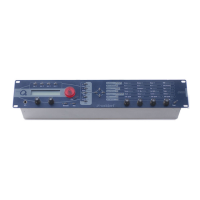Sound Parameters – Arpeggiator
Waldorf microQ User´s Manual 104
• If Each Note is selected, each note of the arpeggio is played back with the velocity that you
originally played.
• If First Note is selected, the first note you played sets the velocity for all arpeggio steps.
• If Last Note is selected, the last note you played sets the velocity for all arpeggio steps.
T. Factor 0…127
Determines how much the Arp Timing parameter affects an arpeggio step. If T. Factor is set to 0, the
settings in Arp Timing are completely ignored and the arpeggio is played back without any shuffled
timing. Settings from 1 to 127 increase the shuffling of the notes depending on the setting in the Arp
Timing parameter. T. Factor also works on ROM patterns; these are set up with standard swing
rhythm.
Same Note Overlap Off / On
Same Note Overlap
Off
Due to the various Length parameters, it might happen that two notes having equal pitch overlap,
e.g. when you play only one single note on a 16 beat rhythm with lengths set to 1/8.
Note that this parameter only affects notes of the same pitches. If you want to control the lengths of
notes of different pitches, use the Length or Arp Steplen parameters.
• If On is selected, the Note Off message of the previous note is allowed to be sent after a Note
On message of the next note with the same pitch. This setting can be nice with arpeggios
triggering sounds with slow attack.
• If Off is selected, the Note Off message of the previous note is sent right before the next note
with the same pitch is started.
Pattern Reset Off / On
Pattern Reset
Off
When all steps of an arpeggio pattern are played back, the pattern is repeated from the beginning so
that the arpeggio is looped. With Pattern Reset, you can decide if the note list is also restarted from
the beginning when the rhythm pattern is reset.
• If Off is selected, the note list is not restarted, so that there is no synchronization between
rhythm and note list. E.g., when you have a pattern where four steps are set and you play
three notes, the pattern and the note list are repeated differently. The pattern restarts after
the fourth step while the note list restarts after the third step. The arpeggio might look like
this:
•
Pattern Step 1 2 3 4 1 2 3 4 1 2 3 4 1 2 3 4
Note C1 E1 G1 C1 E1 G1 C1 E1 G1 C1 E1 G1 C1 E1 G1 C1
Table 11: Arpeggio with Pattern Reset set to On
• If On is selected, the note list will be restarted as soon as the rhythm pattern is restarted.
The same arpeggio might now look like this (note the two C1s in sequence):

